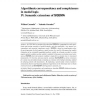31 search results - page 2 / 7 » Where the monotone pattern (mostly) rules |
JANCL
2008
13 years 5 months ago
2008
ABSTRACT. In [CON 06b] we introduced the algorithm SQEMA for computing first-order equivalents and proving canonicity of modal formulae, and thus established a very general corresp...
COLT
1992
Springer
13 years 9 months ago
1992
Springer
We consider learning in situations where the function used to classify examples may switch back and forth between a small number of different concepts during the course of learnin...
KDD
2000
ACM
13 years 8 months ago
2000
ACM
Higher quality synthesized speech is required for widespread use of text-to-speech (TTS) technology, and prosodic pattern is the key feature that makes synthetic speech sound unna...
ISCI
2007
13 years 5 months ago
2007
In this paper, we propose a novel spatial mining algorithm, called 9DLT-Miner, to mine the spatial association rules from an image database, where every image is represented by th...
AUSAI
2005
Springer
13 years 10 months ago
2005
Springer
Most data-mining techniques seek a single model that optimizes an objective function with respect to the data. In many real-world applications several models will equally optimize...

